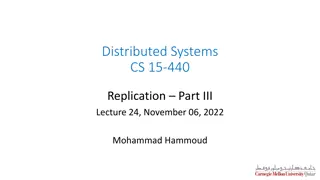Dynamo and Bayou: High Availability and Weak Consistency in Modern Applications
Dynamo and Bayou databases offer high availability and weak consistency, making them suitable for modern applications with super high demands. Examples of suitable applications include flight ticket booking, Amazon shopping carts, and more. Availability is crucial for accommodating millions of customers and fulfilling strict SLAs. Techniques like consistent hashing, vector clocks, and anti-entropy ensure availability and fault tolerance in these systems.
Download Presentation

Please find below an Image/Link to download the presentation.
The content on the website is provided AS IS for your information and personal use only. It may not be sold, licensed, or shared on other websites without obtaining consent from the author.If you encounter any issues during the download, it is possible that the publisher has removed the file from their server.
You are allowed to download the files provided on this website for personal or commercial use, subject to the condition that they are used lawfully. All files are the property of their respective owners.
The content on the website is provided AS IS for your information and personal use only. It may not be sold, licensed, or shared on other websites without obtaining consent from the author.
E N D
Presentation Transcript
Dynamo / Bayou Feb 23rd& 24th, 2022 [Adapted from Andrew Or s]
Some context... Dynamo and Bayou both offer high availability and weak consistency Most traditional databases offer strong consistency and low availability Not suitable for modern applications with super high demands What are some example applications of each? Flight ticket booking (HA) Amazon shopping carts (HA) Offline edits (HA) Billing services (SC) Bank accounts (SC)
Availability is important Tens of millions of customers at peak times Tens of millions of shopping cart requests, 3 million checkouts per day Hundreds of thousands of concurrently active sessions Strict Service-Level Agreements (SLAs) translate to business value
Dynamo Fully decentralized, highly available key-value store Always writeable, resolve conflicts during reads --- Eventual Consistency API for clients to specify requirements (99.9th percentile) Departure from RDBMS: simpler functionality, fewer guarantees, runs on commodity hardware (low-end, broadly compatible, non-specialized machines) (Read the original paper, especially Section 4)
Techniques for achieving availability Consistent hashing for partitioning key space Vector clocks for reconciling conflicts during reads Sloppy quorums for handling temporary failures Anti-entropy using Merkle trees for syncing key-value pairs Gossip-based protocol for membership notifications
Techniques for achieving availability Consistent hashing for partitioning key space Vector clocks for reconciling conflicts during reads Sloppy quorums for handling temporary failures Anti-entropy using Merkle trees for syncing key-value pairs Gossip-based protocol for membership notifications
Consistent Hashing Virtual Nodes Assign each node a random position on the ring Node owns the preceding key range For fault tolerance, replicate each key at N successor nodes in the ring Virtual nodes: each physical node gets assigned multiple nodes on the ring (e.g. B, D, F)
Consistent Hashing Desirable properties? Uniform distribution of load Minimum object movements when nodes join or leave the ring Number of virtual nodes can be adjusted for device heterogeneity
Techniques for achieving availability Consistent hashing for partitioning key space Vector clocks for reconciling conflicts during reads Sloppy quorums for handling temporary failures Anti-entropy using Merkle trees for syncing key-value pairs Gossip-based protocol for membership notifications
Conflict resolution Two machines write different values to the same key Vector clocks: list of (node, count) pairs where count is incremented on write If one vector clock subsumes another, discard older value Else, return all conflicting values to client
Context contains vector clocks Dynamo client API is simple: get(key) (value, context) put(key, value, context) Common pattern: put after get
Conflict resolution Two machines write different values to the same key Vector clocks: list of (node, count) pairs where count is incremented on write If one vector clock subsumes another, discard older value Else, return all conflicting values to client
Techniques for achieving availability Consistent hashing for partitioning key space Vector clocks for reconciling conflicts during reads Sloppy quorums for handling temporary failures Anti-entropy using Merkle trees for syncing key-value pairs Gossip-based protocol for membership notifications
Sloppy Quorums Write to N nodes, return success when W < N nodes respond Read from N nodes, return value(s) from R < N nodes Typically, W+R > N means at least one writer and one reader overlap, so values are consistent Sloppy here means skip nodes that have failed, such that even if W+R > N, the readers and writers may not overlap = not consistent!
Sloppy Quorums Example: Typical values are N = 3, W = R = 2 Nodes C and D have failed, so key k is written to E and F instead Nodes C and D recover, and now client tries to read from C and D = stale value
Hinted Handoff Hint refers to the node the data originally belongs to Example: Nodes E and F remember they are writing on behalf of C and D As soon as C and D recovers, E and F transfer their values for k to C and D
Sloppy Quorums Write to N nodes, return success when W < N nodes respond Read from N nodes, return value(s) from R < N nodes Typically, W+R > N means at least one writer and one reader overlap, so values are consistent Sloppy here means skip nodes that have failed, such that even if W+R > N, the readers and writers may not overlap = not consistent!
Techniques for achieving availability Consistent hashing for partitioning key space Vector clocks for reconciling conflicts during reads Sloppy quorums for handling temporary failures Anti-entropy using Merkle trees for syncing key-value pairs Gossip-based protocol for membership notifications
Anti-entropy using Merkle trees Goal: minimize durability loss from above techniques Nodes responsible for the same key spaces exchange Merkle trees Find differences quickly while exchanging little information
Techniques for achieving availability Consistent hashing for partitioning key space Vector clocks for reconciling conflicts during reads Sloppy quorums for handling temporary failures Anti-entropy using Merkle trees for syncing key-value pairs Gossip-based protocol for membership notifications
Membership notification Gossip-based protocol to propagate membership changes Each node learns the key spaces handled by all other nodes Result: zero-hop distributed hash table (DHT) Clearly not infinitely scalable, but storage requirement not a problem in practice
Bayou What is it? - Weakly consistent, replicated storage system Goals: - - - Maximize availability, support offline collaboration Minimize network communication Agree on all values (eventually)
Primary Versions Bayou Writes P: 0 A: 0 B: 0 W(X, 4) Client 1 Legend Commit Timestamp:Write Timestamp:Write Server A B Versions Versions P: 0 A: 0 B: 0 P: 0 A: 0 B: 0
Primary Versions Bayou Writes P: 1 A: 0 B: 0 :1:P W(X,4) Client 1 Legend Commit Timestamp:Write Timestamp:Write Server A B Versions Versions P: 0 A: 0 B: 0 P: 0 A: 0 B: 0
Primary Versions Bayou Writes P: 1 A: 0 B: 0 :1:P W(X,4) Client 1 W(Y, 8) Legend Commit Timestamp:Write Timestamp:Write Server Client 2 W(X, 3) A B Versions Versions P: 0 A: 0 B: 0 P: 0 A: 0 B: 0
Primary Versions Bayou Writes P: 7 A: 0 B: 0 :1:P :7:P W(X,4) W(Y,8) Client 1 W(Z, 8) Legend Commit Timestamp:Write Timestamp:Write Server Client 2 A B Versions Versions W(Y, 4) P: 0 A: 7 B: 0 P: 0 A: 0 B: 0 :7:A W(X,3)
Primary Versions Bayou Writes P: 7 A: 0 B: 0 :1:P :7:P W(X,4) W(Y,8) Legend Commit Timestamp:Write Timestamp:Write Server A B Versions Versions P: 0 A: 12 B: 0 P: 0 A: 0 B: 5 :5:B W(Z,8) :7:A W(X,3) :12:A W(Y,4)
P :1:P :7:P Versions Bayou Anti-Entropy P: 7 A: 0 B: 0 W(X,4) W(Y,8) Anti-Entropy Session A & B A :7:A :12:A W(Y,4) B Versions Versions P: 0 A: 0 B: 5 :5:B W(Z,8) P: 0 A: 12 B: 0 P: 0 A: 0 B: 5 :5:B W(Z,8) W(X,3) P: 0 A: 12 B: 0 :7:A :12:A W(Y,4) W(X,3)
P :1:P :7:P Versions Bayou Anti-Entropy P: 7 A: 0 B: 0 W(X,4) W(Y,8) A :5:B :7:A :12:A W(Y,4) B Versions Versions P: 0 A: 12 B: 5 P: 0 A: 12 B: 5 :5:B :7:A :12:A W(Y,4) W(Z,8) W(Z,8) W(X,3) W(X,3)
P 1:1:P 2:7:P Versions Bayou Commit P: 7 A: 0 B: 0 W(X,4) W(Y,8) Primary commits its entries A :5:B :7:A :12:A W(Y,4) B Versions Versions P: 0 A: 12 B: 5 P: 0 A: 12 B: 5 :5:B :7:A :12:A W(Y,4) W(Z,8) W(Z,8) W(X,3) W(X,3)
P 1:1:P 2:7:P Versions Bayou Write P: 7 A: 0 B: 0 W(X,4) W(Y,8) Write after anti-entropy session Write timestamp = max(clock, max(TS)+1) Client 1 D(Y) A :5:B :7:A :12:A W(Y,4) B Versions Versions P: 0 A: 12 B: 5 P: 0 A: 12 B: 13 :5:B :7:A :12:A W(Y,4) :13:B D(Y) W(Z,8) W(Z,8) W(X,3) W(X,3)
P 1:1:P 2:7:P Versions Bayou Anti-Entropy P: 7 A: 0 B: 0 W(X,4) W(Y,8) Anti-Entropy Session P & B P: 0 A: 12 B: 13 :5:B :7:A :12:A W(Y,4) :13:B D(Y) W(Z,8) W(X,3) A :5:B :7:A :12:A W(Y,4) B Versions Versions 1:1:P 2:7:P W(X,4) P: 0 A: 12 B: 5 P: 0 A: 12 B: 13 :5:B :7:A :12:A W(Y,4) :13:B D(Y) W(Z,8) W(Z,8) W(Y,8) W(X,3) W(X,3) P: 7 A: 0 B: 0
P 1:1:P 2:7:P :5:B :7:A :12:A W(Y,4) :13:B D(Y) Versions Bayou Anti-Entropy P: 7 A: 12 B: 13 W(X,4) W(Y,8) W(Z,8) Anti-Entropy Session P & B Primary respects causality W(X,3) A :5:B :7:A :12:A W(Y,4) B Versions Versions P: 0 A: 12 B: 5 P: 7 A: 12 B: 13 1:1:P 2:7:P :5:B :7:A :12:A W(Y,4) :13:B D(Y) W(X,4) W(Z,8) W(Y,8) W(Z,8) W(X,3) W(X,3)
P 1:1:P 2:7:P 3:5:B 4:7:A 5:12:A W(Y,4) 6:13:B D(Y) Versions Bayou Commit P: 7 A: 12 B: 13 W(X,4) W(Y,8) Primary commits Its entries W(Z,8) W(X,3) A :5:B :7:A :12:A W(Y,4) B Versions Versions P: 0 A: 12 B: 5 P: 7 A: 12 B: 13 1:1:P 2:7:P :5:B :7:A :12:A W(Y,4) :13:B D(Y) W(X,4) W(Z,8) W(Y,8) W(Z,8) W(X,3) W(X,3)
P 1:1:P 2:7:P 3:5:B 4:7:A 5:12:A W(Y,4) 6:13:B D(Y) Versions Bayou P: 7 A: 12 B: 13 W(X,4) W(Y,8) After a number of commits and anti-entropy sessions (without further writes) W(Z,8) W(X,3) A 1:1:P 2:7:P 3:5:B 4:7:A 5:12:A W(Y,4) 6:13:B D(Y) B Versions Versions P: 7 A: 12 B: 13 P: 7 A: 12 B: 13 1:1:P 2:7:P 3:5:B 4:7:A 5:12:A W(Y,4) 6:13:B D(Y) W(X,4) W(X,4) W(Y,8) W(Y,8) W(Z,8) W(Z,8) W(X,3) W(X,3)
Bayou and Dynamo similarities Anti-entropy to achieve eventual consistency Exchange vector clocks to determine order of operations Expose conflict resolution to application High availability!























